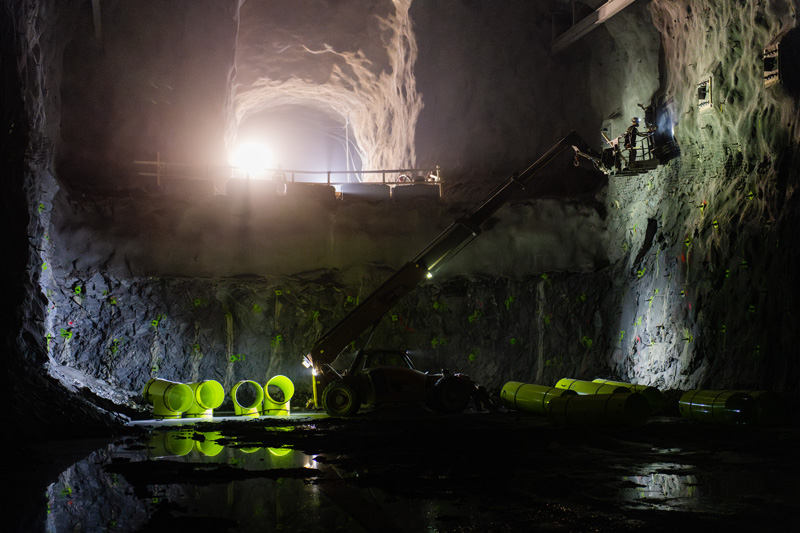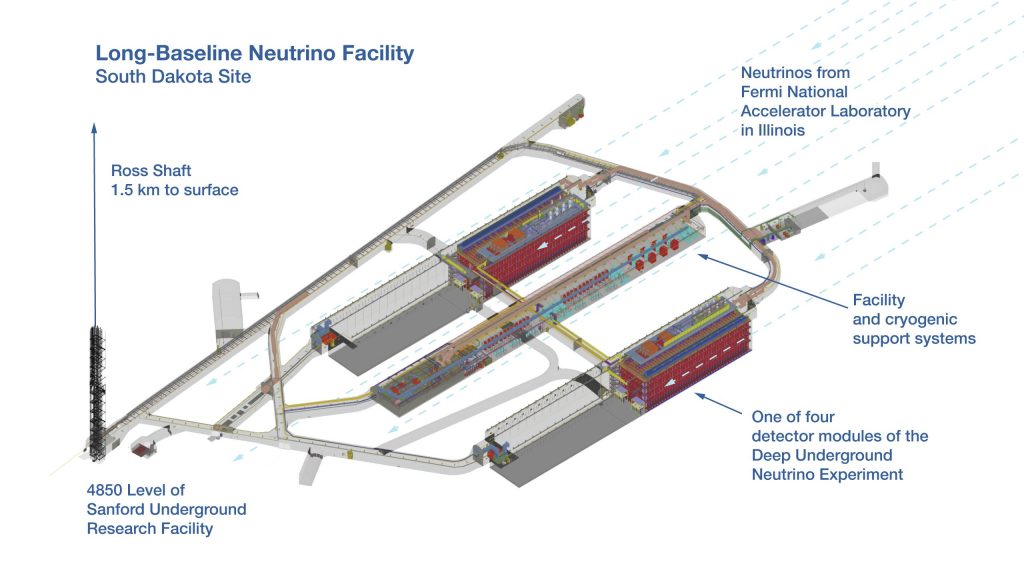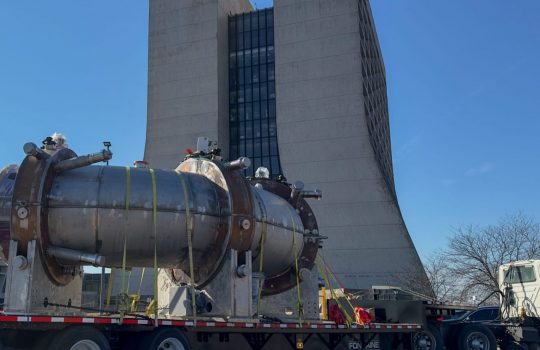A mile below the surface in South Dakota, massive subterranean caverns are taking shape. These will one day become part of the the Long-Baseline Neutrino Facility, home to the international Deep Underground Neutrino Experiment. Since 2021, construction crews in South Dakota have extracted about 550,000 tons of rock.
As excavation nears completion, the LBNF/DUNE project team is now preparing for the next phase of construction, which will turn the underground cavities into a laboratory-ready space.
“The excavation is exceeding 70% completion,” said Ron Ray, the U.S. deputy project director of LBNF/DUNE. “As soon as the caverns have been excavated, then we have to turn them into usable laboratory space.”
That’s where the Building and Site Infrastructure subproject, or BSI, comes in. During this phase, workers will outfit the caverns with all the systems — including electricity, plumbing, telecommunications and IT, air conditioning, fire detection and protection, elevators and additional ventilation — needed to run the underground research facility. In March, the U.S. Department of Energy gave the LBNF/DUNE project team the approval to proceed with the BSI subproject.

More than 70% of the excavation of the South Dakota portion of the Long-Baseline Neutrino Facility for the Deep Underground Neutrino Experiment is complete. Photo: Ryan Postel, Fermilab
DUNE, hosted by DOE’s Fermi National Accelerator Laboratory, is an experiment focused on the study of elusive particles known as neutrinos. DUNE scientists hope to solve some the universe’s great mysteries by exploring the behavior of neutrinos: Why is our universe composed of matter? How do black holes and neutron stars form? Can the four forces of nature be combined in a single, unified theory?
LBNF will provide the space, infrastructure and particle beam for DUNE. This includes the underground caverns that will house DUNE’s detectors — a near detector at Fermilab and a far detector 800 miles away at the Sanford Underground Research Facility in South Dakota.
Once the excavation at SURF is complete, the site will be composed of three caverns and a network of tunnels that, together, span the area of approximately eight soccer fields. The north and south caverns, each about the height of a seven-story building, will house the far detector modules, which each will contain 17,500 tons of ultrapure liquid argon — a highly stable element ideal for studying neutrinos — cooled to minus 184 degrees Celsius. The third cavern, known as the central utility cavern, will house the cryogenic support systems, detector electronics and data acquisition equipment.
“The biggest part of our scope is providing the power and the corresponding cooling systems to support the experiment,” said Josh Willhite, BSI subproject manager. “Throughout all of the drifts and caverns, we will install lighting, sprinklers and fire alarm systems, and then the central utility cavern is where we put in an electrical substation and a chilled water system that ultimately removes the heat from underground.” The BSI team will also set up a structure on the surface for receiving deliveries of argon.
The architecture and engineering company Arup USA developed the blueprints for the infrastructure that will be installed during BSI. The contractor Kiewit Alberici Joint Venture will manage the BSI work. KAJV will procure subcontractors from areas including South Dakota and nearby regions over the next six-to-eight months to carry out this next phase of the LBNF/DUNE construction. KAJV will also perform some of the BSI work in-house.
“Most of the recommended subcontractors to date are from South Dakota,” said Scott Lundgren, project manager for KAJV. “We’ve also got quite a few from North Dakota, Minnesota, Wyoming and Denver.”
Excavation and BSI are two of five LBNF/DUNE subprojects. The third, which comes after BSI, is the Far Detector and Cryogenics subproject that includes the installation of the huge neutrino detectors in the caverns. The final two subprojects will take place at Fermilab. One involves building the facilities to support the near detector and beam line, as well as building the beam line itseslf. The other is to build the near detector.

Preparations for turning the huge caverns excavated for the Long-Baseline Neutrino Facility into usable laboratory space for the Deep Underground Neutrino Experiment are underway. Image: Fermilab
The LBNF caverns provide space for four far detector modules. Members of the DUNE collaboration have successfully tested the technology and assembly process for the first detector module, and mass production of the components of this module is currently underway. Preparations for testing the technology underlying the second detector module are underway at the European research laboratory CERN.
The FDC phase will involve several steps: constructing the cryostats; installing the detectors and cryogenic systems; and filling the detectors with liquid argon. It will involve more than 1,300 collaborators from 204 institutions in 33 countries plus CERN.
“This is a huge international effort,” Ray said. “We have significant contributions from our partners all over the world.”
The BSI phase is expected to start in summer 2024. Workers will begin in the north cavern, with the goal of completing infrastructure installation in that cavern by fall 2024. Once that north cavern is complete, the construction of the first far detector will begin. The FDC team aims to have the first detector module complete and operational before the end of 2028.
“One of the big milestones would be getting started with BSI next summer, which means finishing the excavation and transitioning into the first of the cavern fit-out work,” Lundgren said. “If everything lines up, the first of the cryostat assembly will start late 2024, which inches things ever closer to the ultimate milestone: starting the science.”
Fermi National Accelerator Laboratory is supported by the Office of Science of the U.S. Department of Energy. The Office of Science is the single largest supporter of basic research in the physical sciences in the United States and is working to address some of the most pressing challenges of our time. For more information, please visit science.energy.gov.



